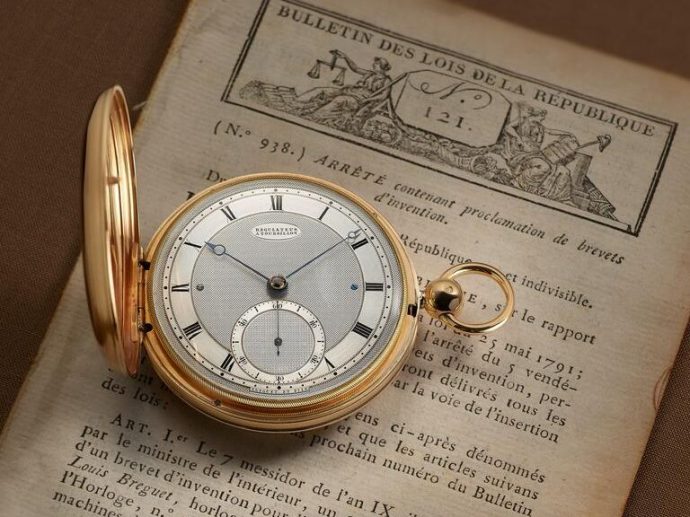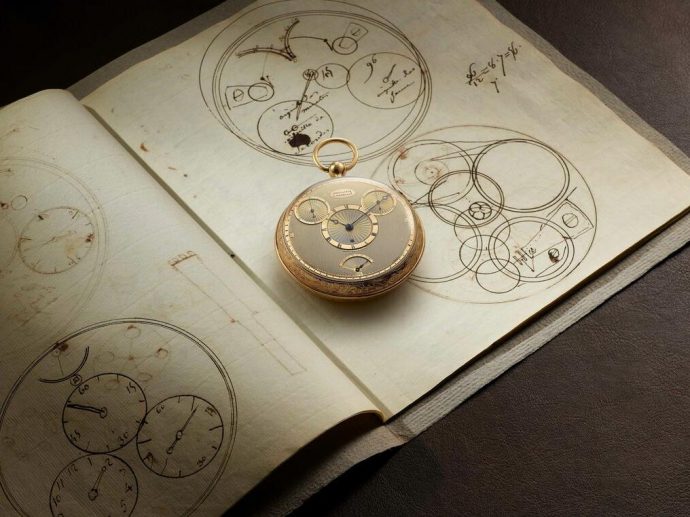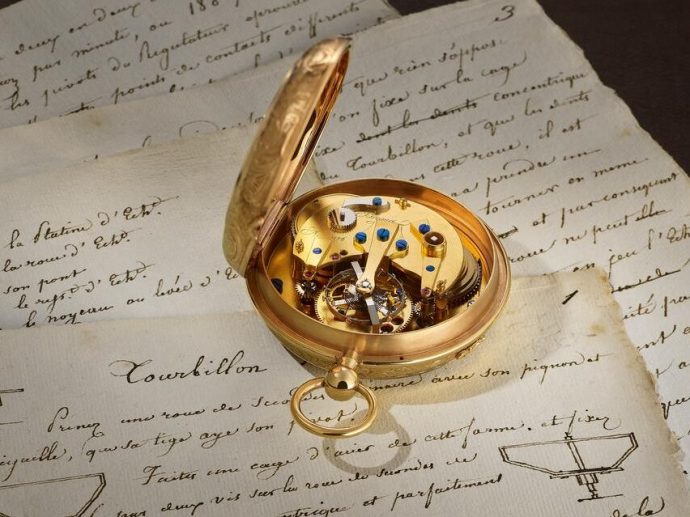Categories more
- Adventures (17)
- Arts / Collectables (15)
- Automotive (37)
- Aviation (11)
- Bath, Body, & Health (77)
- Children (6)
- Cigars / Spirits (32)
- Cuisine (16)
- Design/Architecture (22)
- Electronics (13)
- Entertainment (4)
- Event Planning (5)
- Fashion (46)
- Finance (9)
- Gifts / Misc (6)
- Home Decor (45)
- Jewelry (41)
- Pets (3)
- Philanthropy (1)
- Real Estate (16)
- Services (23)
- Sports / Golf (14)
- Vacation / Travel (60)
- Watches / Pens (15)
- Wines / Vines (24)
- Yachting / Boating (17)
Published
02/18/2021 by BreguetThe year 2021 marks the 220th anniversary of one of the greatest watchmaking complications of all times: the Tourbillon. An exquisite mechanism of unrivaled complexity, the invention lies at the heart of a genuine human adventure that, to this day, contributes extensively to the reputation of its creator Abraham-Louis Breguet and his House.
An expression of their era, technical inventions rarely maintain their relevance from one century to the next. One innovation replaces another, and as they are swept away by the stream of continual progress, they invariably fade into oblivion. With a few exceptions…
Developed 220 years ago by Abraham-Louis Breguet (1747–1823), the Tourbillon has never been as vital to fine horology as it is today. Regarded as one of the greatest complications of all time, it continues to flourish at the House of Breguet, its custodian. However, it has also been adopted by a number of other watchmaking brands because when Breguet patented it in 1801 it did so for only 10 years! Throughout the 19th century, it inspired other engineers, among them Bahne Bonniksen who, based on the observations made by Breguet, invented the carousel.
The fascination with Breguet’s invention derives from its very genesis: The Tourbillon is more than just a mechanical work of art – it is the result of a precise study of physics, a human adventure and an industrial saga in its own right. In 2021, the House of Breguet will commemorate its founder’s ingenuity, and the treasure that is the Tourbillon, through various events and the celebration of a new model on June 26. When the patent was obtained in 1801, the date correlated with the post-revolutionary Republican calendar of France – “7th Messidor of the year IX,” which refers to June 26th on our modern day calendars.
The Origins of the Tourbillon
One Man
The Tourbillon sprang from the brilliant mind of a man who had already carved out a successful career for himself. Abraham-Louis Breguet, born in 1747 in Neuchâtel in Switzerland, was apprenticed to a watchmaker, and at the age of 15, he traveled to France to continue his apprenticeship in Versailles and Paris. In the French capital, a world metropolis even then, young Breguet obtained an academic education, most notably at Mazarin College. It provided a strong foundation in sciences, particularly mathematics and physics, which to all intents and purposes made Breguet an engineer before the time. He set up his own business on Île de la Cité in 1775, and by the time he presented his idea of the Tourbillon and applied to the authorities for a patent, he was already looking back on a long career. His so-called Perpétuelle, or self-winding, watch enchanted first King Louis XVI and Queen Marie-Antoinette and eventually the entire court at Versailles. Countless technical innovations and a talent for sleek, minimalist design made Breguet an innovator of international repute. His name became known in all the major capitals, and many started to imitate him.
The Quest for Precision
In 1793, Breguet was forced to flee the excesses of the French Revolution and seek refuge in the country of his birth. He lived in Switzerland for two years, first in Geneva, then in Neuchâtel, and finally in Le Locle. This would turn out to be a fruitful sabbatical, a period of intense intellectual work and exchange with the Swiss watchmakers of the Geneva and Neuchâtel Jura regions. Upon his return to France in the spring of 1795, his various observations lent a spectacular new lease on life to his career.
During the five years following Breguet’s return to Paris, the Maison presented new products to a clientele that had long become international and cosmopolitan. Among these novelties were the tactile watch (which allows time to be read by touch), the Sympathique clock (which resets and synchronizes watches placed on top of it), the subscription watch (breathtaking in its minimalism), a new constant-force escapement, and a new mechanism referred to as a “Tourbillon regulator.”
Defying the Laws of Physics
Through study and observation, Breguet had perfected his understanding of the factors – especially those affecting the escapement – that might impair the precision of a timepiece. He was without question the only watchmaker of his time who had, through first-hand experience, absorbed and synthesized the achievements of the three major contemporary watchmaking nations (Switzerland and France as well as England, which he visited on several occasions, spending time particularly with John Arnold). Realizing that he would not be able to solve single-handedly all the problems associated with the expansion of metals and the stability of oils, Breguet coped with those issues by working around them. He “compensated” for the effects of the laws of physics that affect the inner workings of a watch and, with them, its rate regularity. As Breguet was unable to alter the law of gravity, he chose to “tame” its effects.
The Meaning of a Word
Who but Breguet could have proposed such a project? It required a solid grasp of science as well as an optimistic streak. This specific set of circumstances resulted in a project, which its inventor named “Tourbillon.” The word is frequently misinterpreted and its astronomical meaning has long been forgotten. According to the major dictionaries of the 19th century, among them Descartes and the Encyclopédie, the word referred either to a planetary system and to its rotation on a single axis, or to the energy that causes the rotation of the planets around the sun. This sense of the word is far from its modern meaning of “violent rotation” or “uncontrollable storm.” A man of the Enlightenment, Breguet thus chose a word that someone who observed the world before imitating it would choose. In this, he resembles the 18th century philosophers who considered watchmaking to be the creation of a microcosm.
In fact, it is hard not to envision a tiny, tidily ordered constellation in this mechanism, which assembles the devices for regulation (balance spring) and transfer (escape wheel and lever) in a mobile cage that spins as constantly as any planet…
Letter to the Minister and Dossier
In 1801, France was (already) under the rule of powerful, bureaucratic authorities, and in order to obtain his patent, Breguet had to overcome the hurdles posed by the application file, which had to include an illustrative watercolor plate and be prefixed by a letter to the Minister of the Interior.
A Long Road
Assuming that the idea for the Tourbillon sprouted in Breguet’s mind between 1793 and 1795 (during his time in Switzerland), its realization then took six years, from his return to Paris until the patent on June 26, 1801 was obtained. It then took another six years for sales to pick up. This suggests that Breguet had likely underestimated the difficulties of fine-tuning this new type of regulator – another result of his habitual optimism – and that the “considerable expense” and “sacrifices” that he mentioned in his letter to the Minister of the Interior did not end in 1801…
In other words, it took Abraham-Louis Breguet more than ten years not only to develop his extremely complex invention, but also to make it reliable. The master watchmaker mentioned his invention at every opportunity and promoted it at the French industrial fairs held in Paris in 1802, 1806 and 1819. He praised it as a mechanism, which allowed timepieces to “maintain their accuracy, irrespective of whether the position of the watch is upright or tilted.”
Convinced of the significance of the invention, which could be installed in different types of timepieces, Breguet and his staff went on to produce 40 Tourbillons between 1796 and 1829 – plus nine other pieces which were never finished and appeared in the ledgers as written-off, scrapped or lost…
Famous Customers and Applications
Thorough research of the available archive materials has made it possible to draft a precise list, outlining the history of each one of these pieces. There are 35 watches, more than half of which possess a cage that revolves at a rate of once per four or six minutes, whereas the patent describes a cage revolving every minute. There also are five other unique items: a Sympathique clock and a clock and watch set, a large-scale model for demonstration purposes, a naval chronometer and a travel clock…
Among Breguet’s clients featured, unsurprisingly, monarchs (George III and George IV of England, Ferdinand VII of Spain), Russian aristocrats (Princes Yermoloff, Gagarin, Repnin, Demidoff and others) as well as prominent European personalities from Poland (Count Potocki), Prussia (Prince Hardenberg), Italy (Count d’Archinto, G.B. de Sommariva), Hungary (Baron Podmaniczky) and Portugal (Chevalier de Brito).
Only recently, it became widely known that a quarter of these 40 Tourbillons were likely used for naval purposes – in other words, they were bought by ship owners or sailors and used for navigation at sea and for calculating longitude. An explorer in Africa used the watch for the same purpose. Thomas Brisbane reached Australia with his. Some pieces were used on the global ocean for half a century. Several pieces even belonged to leading scientists.
Clearly, and in line with Breguet’s own classification, the Tourbillon fell into the category of watchmaking for scientific use rather than watchmaking for civilian use. These buyers understood and benefited from the increased precision offered by the mechanism.
A Complex Success
Appointed with a gold or silver case, these Tourbillons are works of art whose aesthetic matches their technological brilliance. Although they were considered to be purely scientific objects, they were given a sophisticated finish. The dials of the Tourbillons are among the most beautiful in the history of the House. Perfect readability – a characteristic of any Breguet watch – and dials whose functionality was enhanced by gold, silver or enamel: constant seconds, seconds on demand, power reserve, sometimes even a thermometer… no two pieces were the same. The Tourbillon mechanism could be adapted to several types of escapements and watches.
Production, on the other hand, was very slow. In 1802, once the patent had been obtained, work began on six Tourbillon timepieces. The creation of each of these pieces would take between five and ten years. In 1809, taking advantage of his booming business and hoping that the opening of his branch in St. Petersburg would also open the Russian market for him, Breguet started work on the production of 15 new Tourbillons, half of which were completed after 1814. The marine Tourbillon chronometer would remain unique, just as the travel clock, the last Tourbillon from the original series. Creating these pieces was fraught with difficulty, the time required for fine-tuning was lengthy, and the skilled labor capable of creating them scarce.
While the Tourbillon satisfied Breguet’s followers, it did not offer its creator a reasonable economic trade-off for his efforts. The actual trade-off was different and inherent in the fact that Breguet’s life-long quest was to improve the functioning of timepieces. In the end, it led him to... simplicity!
The Tourbillon, the shooting star in the watchmaking sky, the brilliant idea borne of Enlightenment thinking, faded – but it never disappeared completely. It had not had its final turn.
A Revered and Inspiring Heritage
Precious testament to a fertile past, the Tourbillons dating from the time of their inventor continued to fascinate collectors, historians, and major players in watchmaking, from George IV of England to Sir David Salomons and from George Daniels to Nicolas G. Hayek. Twelve pieces are preserved in museums: three belong to the collections of the Breguet Museum, five are kept in the British Museum and other museums in England, the other ones can be found in Italy, Jerusalem, and New York. A further fifteen are in the hands of private collectors, and in recent years, two pieces were bought at auction. In total, almost 30 out of the 40 original pieces have survived, a proportion that speaks volumes to the fascination at play.
A Rapid Resurgence
The House of Breguet not only preserved its founder’s pieces with great care, but it also created a selection of new Tourbillon pocket watches that were sold from the 1920s into the 1950s. Only a small number of insiders knew about this.
The revival, when it came at last, was as swift as it was unexpected. Although designed for pocket watches, which were generally worn upright, Abraham-Louis Breguet’s invention made its comeback in the mid-1980s, in the much smaller cases of wristwatches that were far less sensitive to gravity. How ironic! Since then, the triumph of the Tourbillon has proved unstoppable, and year by year, it gains ground. Today, the main advantage of the Tourbillon no longer lies in increased precision. Instead, the enlightened amateur may delight in the beauty of a brilliant invention, in a chapter of human history and in the reassuring regularity of a revolutionary process (in every sense of the word) which, 220 years later, continues to bear witness to the human spirit.

















